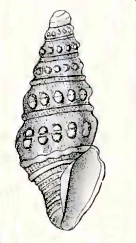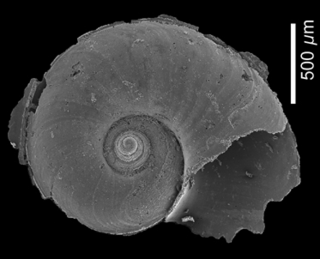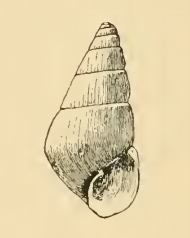
A whorl is a single, complete 360° revolution or turn in the spiral growth of a mollusc shell. A spiral configuration of the shell is found in numerous gastropods, but it is also found in shelled cephalopods including Nautilus, Spirula and the large extinct subclass of cephalopods known as the ammonites.

A protoconch is an embryonic or larval shell which occurs in some classes of molluscs, e.g., the initial chamber of an ammonite or the larval shell of a gastropod. In older texts it is also called "nucleus". The protoconch may sometimes consist of several whorls, but when this is the case, the whorls show no growth lines.

Atlantidae is a family of sea snails, holoplanktonic gastropod molluscs in the clade Littorinimorpha.

The Pterotracheoidea is, according to the Taxonomy of the Gastropoda, a taxonomic superfamily of sea snails or sea slugs, marine gastropod molluscs in the clade Littorinimorpha. They are commonly called heteropods or sea elephants.

Agathotoma phryne is a species of sea snail, a marine gastropod mollusk in the family Mangeliidae.

Aoteadrillia wanganuiensis is a species of sea snail, a marine gastropod mollusk in the family Horaiclavidae.

Splendrillia aoteana is a species of sea snail, a marine gastropod mollusk in the family Drilliidae.

Atlanta brunnea is a species of sea snail, a holoplanktonic marine gastropod mollusk in the family Atlantidae.

Atlanta echinogyra is a species of sea snail, a holoplanktonic marine gastropod mollusk in the family Atlantidae.

Atlanta lesueurii is a species of sea snail, a holoplanktonic marine gastropod mollusk in the family Atlantidae.

Oxygyrus keraudrenii is a species of sea snail, a holoplanktonic marine gastropod mollusk in the family Atlantidae.

Protatlanta souleyeti is a species of sea snail, a holoplanktonic marine gastropod mollusk in the family Atlantidae.

Atlanta is a genus of pelagic marine gastropod molluscs in the family Atlantidae.

Odostomia oregonensis is a species of sea snail, a marine gastropod mollusk in the family Pyramidellidae, the pyrams and their allies.

Odostomia rotundata is a species of sea snail, a marine gastropod mollusk in the family Pyramidellidae, the pyrams and their allies.

Oscilla circinata is a species of sea snail, a marine gastropod mollusk in the family Pyramidellidae, the pyrams and their allies.

Odostomia mauritiana is a species of sea snail, a marine gastropod mollusk in the family Pyramidellidae, the pyrams and their allies.

Tibersyrnola bacillum is a species of sea snail, a marine gastropod mollusk in the family Pyramidellidae, the pyrams and their allies.
Egilina mariella is a species of sea snail, a marine gastropod mollusk in the family Pyramidellidae, the pyrams and their allies.

Drillia rubrozonata is a species of sea snail, a marine gastropod mollusk in the family Drilliidae.




















